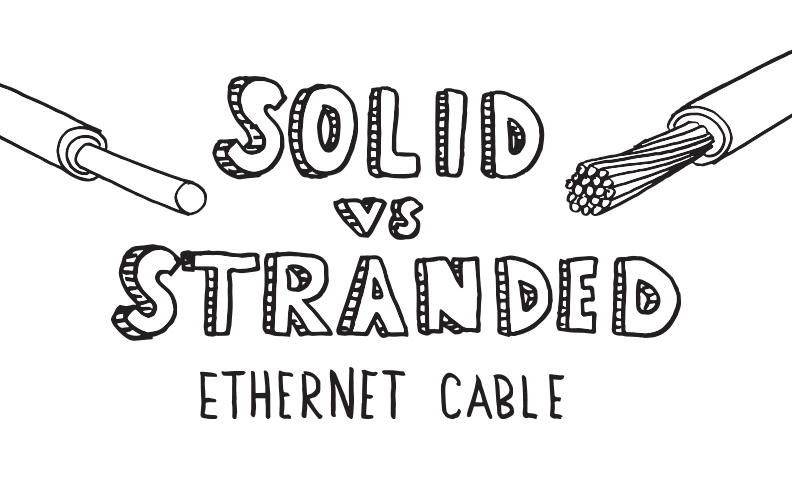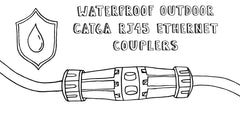Payment methods accepted

Solid vs. Stranded Ethernet Cable
Written by Don Schultz, trueCABLE Senior Technical Advisor, Fluke Networks Copper/Fiber CCTT, BICSI INST1, INSTC, INSTF Certified
So, here you are with your brand-new shiny tools and Ethernet cable and want to start installing it. You made sure to purchase thousands of feet of ultra-high-quality stranded copper cable and have every intention of running it to 800 feet. What could go wrong? If you hear the train getting into a wreck outside your window, that is exactly what you will hear when you go through the pains of installing the wrong cable type and expecting it to work properly.
Stranded copper Ethernet cable is used primarily for short patching applications. Patching applications means from a wall mounted keystone jack to your end device (like a TV or computer) or from a patch panel to an Ethernet switch. Stranded copper Ethernet is typically already terminated at both ends with 8P8C (aka RJ45) plugs and sold in pre-cut and pre-packaged lengths.
If your intention is to permanently install your cable inside your structure, take back the bulk stranded copper stuff. You need solid copper conductors for structured cable.
What is the difference between solid vs. stranded ethernet cable? Doesn’t copper = copper? Yes and no. Yes, copper is good. CCA or Copper Clad Aluminum is bad, which this article explains: Check Your Specs, CCA is Different from Solid Copper.
Another significant difference between solid and stranded copper is how they are terminated in the field. Solid copper is best terminated with IDC style terminations such as keystone jacks, patch panels, and field termination plugs. 8P8C (aka RJ45) connectors are typically only used on factory pre-made stranded copper patch cords, but there are some exceptions. See Choosing the Right Termination - Keystone Jack vs RJ45 Connector vs Field Termination Plug.
Using the correct type of copper conductor is key when installing Ethernet cable. It does not matter what Category type of cable for purposes of this discussion. Copper comes in solid or stranded, and both have pros and cons and specific uses.
How does each solid vs. stranded ethernet cable conductor type look inside an Ethernet cable?

Solid copper pros:
- Allows Ethernet data signals to travel further along a cable with less signal loss. Signal loss is called attenuation. Solid copper has much more surface area than stranded copper and gets a boost from the “skinning effect”.
- Provides a much better platform for use of Power over Ethernet (PoE) via the “skinning effect”, so heat dissipation capability will be far greater.
- Again, with credit given to the “skinning effect” solid copper can go the distance. Whether 24 AWG or 22 AWG, the permitted lengths are the same simply because the copper is solid.
- Solid copper conductors are ideal for outdoor installations. Outdoor installations will be limited in length according to ambient temperatures, and solid copper will provide the longest possible length due to better heat dissipation.
- Solid copper conductor Ethernet cable is usually available in a much greater variety to fit various needs such as in-wall or plenum (HVAC) space installations, and for outdoor scenarios. The outer jacket type matters a great deal, which is addressed here: Facts About Ethernet Cable Jacket Ratings.
Solid copper cons:
- The solid copper conductors are less flexible. This means solid copper Ethernet cable is designed for installation in spots where the cable is not going to be stressed by handling.
- Cable sold in bulk (spool or box) will require the installer to terminate both ends, whether to a keystone jack, patch panel, or RJ45 plug.
Stranded copper Ethernet cables have their place too. In a pinch they are great for connecting two pieces of equipment together temporarily. Stranded copper Ethernet cables, when sold as patch cables, will have RJ45 connector plugs on both ends.
Stranded copper pros:
- Flexibility. Stranded copper patch cables are the preferred and accepted way to connect a device inside a room to a keystone jack, for example. The cable might get handled frequently and the copper strands are able to withstand frequent bending.
Stranded copper cons:
- The stranded copper conductors have small air gaps between the individual copper strands, which causes signal degradation over distance. Those small air gaps don’t transmit signals very well or at all. Although there are on-going debates about this, I personally don’t recommend the use of stranded copper Ethernet cables longer than 75 feet. The official maximum per the standard depends on the gauge of the stranded copper. In the case of 28 AWG, the maximum length is 50 feet.
- Stranded copper conductors, again due to having individual copper strands, causes additional DC resistance for PoE applications especially over distance. Air is an insulator when it comes to electricity. In this scenario, it is especially important to not exceed my 75 foot recommendation for length.
- Often stranded copper Ethernet cable does not come in the cable jacket variety needed to address certain applications, such as outdoor runs or into the plenum space.
Here is an installation graphic that will help distill solid vs. stranded ethernet cables:

So, there you have it. Selecting the correct type of Ethernet cable has more to do with Category and jacket type. There is more to the decision, and when installing your Ethernet cable you want to weigh the pros and cons and use the right type! With that, I will say…
HAPPY NETWORKING!
trueCABLE presents the information on our website, including the “Cable Academy” blog and live chat support, as a service to our customers and other visitors to our website subject to our website terms and conditions. While the information on this website is about data networking and electrical issues, it is not professional advice and any reliance on such material is at your own risk.



































Yet again an excellent and informative article by Don from trueCable. Just last week bought a box of 1000Ft of Solid…. boy Am I glad I went for the solid (awg23) variety. Don perfectly explained the Pro’s and Con’s in clear understandable language.
Thanks Don.
Albert.
Every text book I have read talks about skin effect. Skinning effect is for rabbits